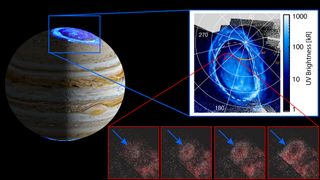NASA's Juno spacecraft detects strange new auroras on Jupiter

NASA's Juno mission has detected new auroral emissions on Jupiter which appear to ripple over the planet's poles.
The Ultraviolet Spectrograph (UVS) on the Juno spacecraft captured this glowing phenomenon, which is characterized by faint ring-shaped emissions that expand rapidly over time at speeds between 2 and 4.8 miles per second (3.3 and 7.7 kilometers per second). Researchers from the Southwest Research Institute (SwRI), where Juno's UVS instrument was built, suggest these auroral emissions are triggered by charged particles coming from the edge of Jupiter's massive magnetosphere, according to a statement from the institute.
"We think these newly discovered faint ultraviolet features originate millions of miles away from Jupiter, near the Jovian magnetosphere's boundary with the solar wind," Vincent Hue, lead author of the study, said in the statement. "The solar wind is a supersonic stream of charged particles emitted by the sun. When they reach Jupiter, they interact with its magnetosphere in a way that is still not well understood."
Related: Glowing 'dawn storm' auroras that blaze in Jupiter's morning skies are born in darkness
Much like on Earth, auroras on Jupiter are linked to charged particles within the planet's magnetosphere. However, Jupiter's magnetosphere is about 20,000 times stronger than Earth's, which means the gas giant can deflect incoming solar winds from up to 4 million miles (6 million km) away.
"The high-latitude location of the rings indicates that the particles causing the emissions are coming from the distant Jovian magnetosphere, near its boundary with the solar wind," Bertrand Bonfond, co-author of the study from Belgium's Liège University, said in the statement.
The charged particles recorded by Juno's UVS instrument appear to be emanating from the outer reaches of the magnetosphere, where plasma from the solar wind interacts with the Jovian plasma. In turn, this interaction may spur the ring-like features, known as Kelvin-Helmholtz instabilities, which could travel along Jupiter's magnetic field lines. Alternatively, the newly detected auroral feature may be the result of dayside magnetic reconnection events, during which interplanetary magnetic fields converge, rearrange and reconnect, according to the statement.
Get the Space.com Newsletter
Breaking space news, the latest updates on rocket launches, skywatching events and more!

"Despite decades of observations from Earth combined with numerous in-situ spacecraft measurements, scientists still do not fully understand the role the solar wind plays in moderating Jupiter's auroral emissions," Thomas Greathouse, co-author of the SwRI study, said in the statement. "Jupiter's magnetospheric dynamics, the motion of charged particles within its magnetosphere, is largely controlled by Jupiter's 10-hour rotation, the fastest in the solar system. The solar wind's role is still debated."
Therefore, the researchers argue that further research is required to fully understand the processes that produce these newly detected ring-like emissions. With NASA's Juno mission recently extended until 2025, the researchers hope to study Jupiter's auroral features in even greater detail.
Their findings were published March 9 in the Journal of Geophysical Research: Space Physics.
Follow Samantha Mathewson @Sam_Ashley13. Follow us on Twitter @Spacedotcom and on Facebook.
Join our Space Forums to keep talking space on the latest missions, night sky and more! And if you have a news tip, correction or comment, let us know at: community@space.com.

Samantha Mathewson joined Space.com as an intern in the summer of 2016. She received a B.A. in Journalism and Environmental Science at the University of New Haven, in Connecticut. Previously, her work has been published in Nature World News. When not writing or reading about science, Samantha enjoys traveling to new places and taking photos! You can follow her on Twitter @Sam_Ashley13.
Most Popular

